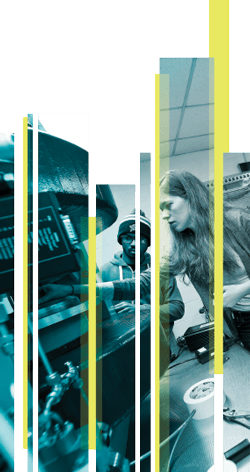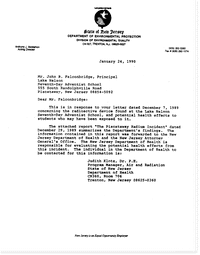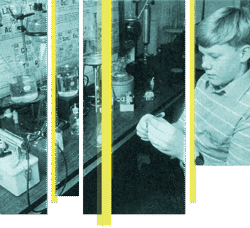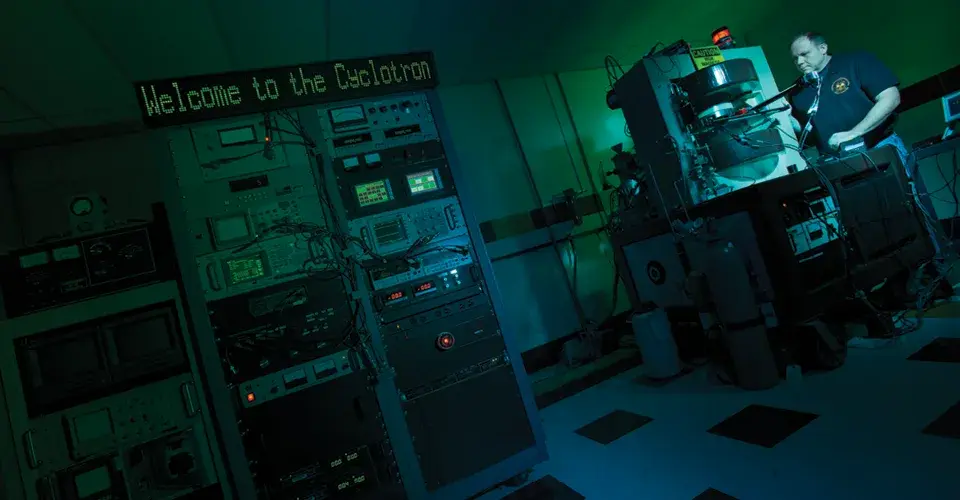Beam Team
Never Heard of a Cyclotron? A Physicist Reveals Its Magic
by Chris Carroll | photo by John T. ConsoliWaking the machine requires nearly an hour of button pushing, switch flipping and fine tuning of knobs, accompanied by the rising hum of vacuum pumps and cooling fans.
Finally, inside a frying pan-sized steel chamber sprouting an octopus-like array of tubes and metal hoses, an intense magnetic field catches an invisible spray of protons and sends it spiraling outward.
The result is a particle beam, and as the electric polarities in the two halves of the circular chamber flip rapidly back and forth from positive to negative, the beam is both pushed and pulled to higher and higher levels of speed and energy.
This is University of Maryland physicist Tim Koeth’s cyclotron, a type of particle accelerator that won its inventor the Nobel Prize in physics in 1939. The beams that cyclotrons produce, while potentially dangerous, accomplish wondrous things—killing cancer cells with extreme precision, for instance, or changing atoms into a different element altogether.
“It’s kind of magical, really—what the medieval alchemists were always trying to do,” says Koeth, an associate research professor in the Institute for Research in Electronics and Applied Physics (IREAP) and UMD’s nuclear reactor and radiation facilities director.
The magic of science aside, Koeth’s 12-inch cyclotron is quite modest, both in comparison to the record holder, a giant with a 59-foot magnet located in Canada, and to other radiation-producing devices he’s worked with throughout his career. Those range from giant particle colliders, measuring kilometers in diameter, to nuclear reactors to the University of Maryland Electron Ring (UMER), where the National Science Foundation is funding groundbreaking studies of intense particle beam control.
"IT'S KIND OF MAGICAL, REALLY–WHAT THE MEDIEVAL ALCHEMISTS WERE ALWAYS TRYING TO DO."
But Koeth’s handmade accelerator has one advantage over all of those more advanced (and costly) devices: He can set undergraduate students loose on it with hex wrenches and screwdrivers.
Koeth has brought undergrads into the lab each week this spring in a unique design class aimed at building a new and larger 19-inch cyclotron—the measurement refers to the size of the magnet used to create the beam—that will crank up the beam strength fivefold compared to his existing machine.

After a few years and several generations of students, the new accelerator should be up and running, achieving what’s known as “first beam.” It will edge out the 12-inch machine to become the largest-ever cyclotron built by undergraduates, Koeth says.
The class is designed to lay the foundation in careers ranging from research to medicine, as well as to introduce students to Koeth’s lifelong vision of science, which is all about devising and building innovations in the lab. It’s an ethic that runs counter to much modern research, in which scientists ask increasingly specialized questions, and often find answers through computerized data analysis.
“To me, physics was always about building your apparatus, then going and making your measurements and refining your approach,” he says. “The prospect of sitting in front of a desk all day was awful.”
Despite running UMD’s radiation facilities, conducting his own research and overseeing students, his cyclotron exerts a special pull on him—and those who work with him say that’s putting it mildly.
“He’s super busy… But with the cyclotron, he’ll be like, ‘Oh yeah, I just spent the whole weekend working on it.’” says Kiersten Ruisard, a fifth-year physics doctoral student working with Koeth on UMER and a teaching assistant in the cyclotron class.
Just what is it about the cyclotron—small and essentially outdated as a research platform—that so motivates a veteran of some of the biggest particle physics projects?
“I ask myself that almost every day,” Koeth admits.
Practically every component of the answer lies in his science-obsessed childhood in the 1970s and ’80s. Barely out of toddlerhood, Koeth, now 41, was enthralled by electricity and the motors and pumps that his father, Bill, a diesel mechanic, sometimes brought home.

“My father loves telling everyone about how they tried taking me to a Toys ‘R’ Us in north Jersey, and I apparently decided to have a temper tantrum,” he says. “I wanted to go next door to the Radio Shack, and when they took me in there, that’s when I was happy.”
His father built an electrical experiment station, powered by a 12-volt battery hidden safely out of reach in the basement, where the young Koeth tore apart radios and other electronic devices, then tried to reassemble them.
His earliest physics experiment—at age 5—was based on the patterns he’d observed in shining flashlight beams on a wall. He crossed two beams when awake at 4 a.m. one morning, expecting them to smash into each other and change appearance. But they shined through each other with no apparent effect.
“I was so excited and curious about this that I woke my parents up and demanded to know why this was,” he says. “Of course, they didn’t know, and it really wasn’t until graduate school that I got the answer.”
As a middle schooler, Koeth’s interest turned toward radiation, and he laid out a diagram on his basement floor for a nuclear reactor that luckily never came to fruition.
To buy a handheld radiation detector called a Geiger counter, he devised “probably my one and only flash of entrepreneurship” when he offered to inspect all of his neighbors’ houses for radiation for a small fee. He didn’t have many takers. Later, Koeth convinced a teacher to give him an unused Civil Defense Geiger counter, which he carried nearly everywhere, and still owns.
One afternoon, while meeting a friend at a school from which he’d transferred, 13-year-old Koeth saw the needle swing wildly. The signal was strongest near a closet door in one of the science classrooms, so he and the teacher dug until they found a box containing a small metal rod. The supremely laid-back teacher was happy to let the boy take the radioactive bauble home.
Once there, Koeth tested it with a detector for industrial-strength doses of radiation. He’d never seen a source strong enough to make it react—until then.
It says something fundamental about the young Koeth that he’d already prepared for just such an outlandish eventuality by lining the interior of a 60-gallon steel drum with concrete—an accepted way to isolate radioactive material. “I put it in there, and then I told my dad,” he says.
Local first responders had trouble believing the call from the elder Koeth, but after a couple of days, New Jersey authorities finally cordoned off his street to mount an emergency response.

Was Koeth terrified of the legal consequences, or of the wrath he’d face from his parents? No. In fact, he was ecstatic as he watched technicians collect the rod and isolate it in a lead-lined container. It turned out to be a “nasopharyngeal radium applicator,” used from the ’40s to the ‘60s to treat ear, nose and throat woes with radiation.
Luckily, none of the radium had flaked off in the Koeth home, sparing the family a complicated cleanup, or even demolition. A state report entitled “The Piscataway Radium Incident” (left) praised eighth-grade Tim for his “unusually high level of understanding and care in handling the source.” Experts calculated he’d only been zapped with as much extra radiation as he’d pick up from natural sources in a year. It was a small price to pay for discovering his career path.
On a February morning, three students lined up at a cluttered counter in the cyclotron lab, scrubbing the greasy innards of an old vacuum pump with alcohol and acetone. It will eventually be one of two pumps evacuating air from the beam chamber of the new 19-inch cyclotron.
Koeth had been saving them in his garage for a decade, waiting for just this moment.
“It’s a revival of the days of students getting their hands dirty,” he says. “I could have cleaned them at any time, but I’ve already done that.”
He got his own hands dirty building the 12-inch cyclotron out of donated and surplus materials as an undergraduate at Rutgers University in the mid-1990s. He’d settled on the idea after realizing that with their massive magnets, kilowatts of electrical power, high-voltage radio frequency systems—all working in concert to produce radiation—cyclotrons represent everything that had captured his scientific imagination as a boy.
He got it running in 1999 and has been lovingly refining and upgrading its capabilities since. He came to the University of Maryland in 2009 as a postdoctoral researcher, and finally brought the machine from New Jersey last fall.
“IT'S A REVIVAL OF THE DAYS OF STUDENTS GETTING THEIR HANDS DIRTY.”
He lured a number of graduate students along with him, including Heidi Baumgartner, a doctoral student in electrical engineering whose investigations center on UMER. As a teenager at astronomy camp, she and friends decided to build their own cyclotron using Koeth’s detailed overview of his own as a guide.
“We thought we could probe the fundamental structure of matter,” Baumgartner says. “We wanted to be the first teenagers to produce antimatter.”
She designed the machine with the help of email advice from Koeth. He later encouraged her to study physics at MIT, where she moved on to bigger things while retaining the do-it-yourself ethic Koeth helped instill.
Undergrad physics major Tom Fowler ’17 started hanging around the cyclotron lab as soon as the machine arrived, even before he registered for the class.
“Hands-on designing and building is basically what I’m all about,” Fowler says. “And here, we’re designing something that’s brand new—not doing the same lab every class before us has done—and we’re designing something that is awesome, something that is going to throw protons at things really, really quickly.”

The ability to extract the beam from the chamber for use in experiments will be one of the major differences between the 12-inch cyclotron and the one being developed, says Brian Beaudoin ’02, M.S. ’08, Ph.D. ’11, an assistant research professor in the Institute for Research in Electronics and Applied Physics. (The beam in the 12-inch cyclotron can be observed and measured inside the chamber, but it dies without ever exiting.)
Like Koeth, Beaudoin spends most of his time on UMER. He got involved with the cyclotron, however, when Koeth convinced him to drive up to Rutgers with him so they could work on it together.
“Being able to tinker with a machine that it doesn’t really matter if it’s broken is really pleasant,” Beaudoin says. “And being able to see the little glow in a student’s eyes when something works—that’s what keeps me going.”
There’s no better way to plunge students into the deep end of accelerator physics than to give them a fully functional machine to work with, even if it’s toylike compared to the multibillion-dollar behemoths, Koeth says.
“Someone could say, ‘Big deal, you spiraled out some protons, you slammed them into a phosphor screen and there was a glow. Why is that exciting?’” he says. “But in doing that, you’ve encountered almost all the principles of accelerator physics, and you’ve had undergraduate students involved through the whole process. That’s what’s unique.”
What do you think of Terp magazine? Take our short survey at terp.umd.edu and be entered to win a Maryland sweatshirt.
1 Comments
Leave a Reply
* indicates a required field


richard van veldhuisen
I love the work that Kiersten Ruisard is doing with Professor Koeth at UM